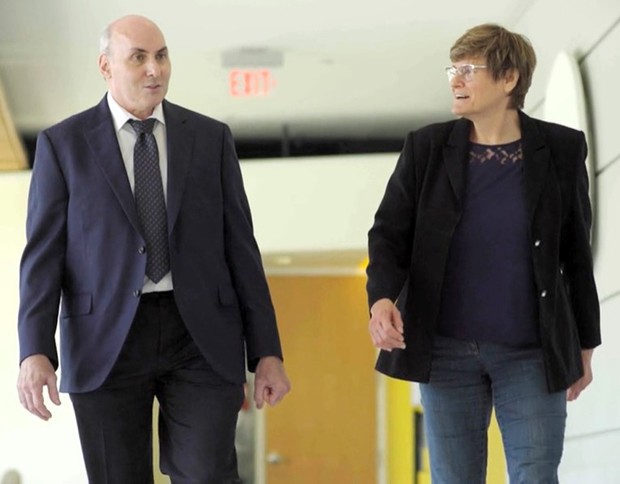[
{
"name": "Top Stories Video Pair",
"insertPoint": "7",
"component": "17087298",
"parentWrapperClass": "fdn-ads-inline-content-block",
"requiredCountToDisplay": "1"
}
]
"I knew that [mRNA] can be used for everything and I had a kind of a Cassandra feeling, that I can see the future and nobody believes me."
Katalin Karikó, winner, with Drew Weissman, of the 2023 the Nobel Prize in Physiology or Medicine
I was overjoyed when, late last year, the Nobel committee announced that two of the world's most deserving scientists had won the Physiology or Medicine category, since their work was responsible for saving millions of people from death by the COVID-19 virus. About 13 billion doses of mRNA vaccines against the virus have now been given in 184 countries, including 600 million in the U.S. alone. While some 7 million people died from the coronavirus, the global death rate would have been orders of magnitude greater had not a new type of vaccine, mRNA (for messenger ribonucleic acid), been readily formulated. For that, we can thank the two Nobel laureates noted above, in particular Hungarian biochemist Katalin Karikó, who foresaw the promise of mRNA vaccines long before COVID-19 threatened us with a global pandemic.
All vaccines work by presenting our bodies with a protein from a virus, causing our cells to make an immune response against that protein. With traditional vaccines (which typically use dead or weakened viruses), manufacturers isolate the virus, grow the vaccine in eggs, purify it, activate it and formulate it, all of which can take years — 10 years for the measles vaccine. Today we have alternates: mRNA vaccines. The usual role of mRNA is to carry genetic information coded in DNA to the cell's watery cytoplasm, where the mRNA is read and translated into amino acids, the building blocks of proteins. In contrast to traditional vaccines, mRNA vaccines have the body do the heavy lifting: Laboratory-made mRNA is inserted directly into the cell, where it directs the manufacture of antibodies. Since all that's needed is the digital sequence of the virus, not virus itself, biotech companies can produce mRNA vaccines quickly, safely and comparatively cheaply.
In the case of COVID-19, after China published the sequence on January 10, 2020 (having delayed publication by two weeks), two companies were able to design mRNA vaccines within hours. These vaccines encode just the "spikes" of the virus, stimulating the body to make its own harmless spike proteins, which then prime our immune cells to regard them as alien. When real COVID-19 enters the body, our immune system recognizes the spikes and renders the virus harmless.
Biochemists were aware of the promise of mRNA vaccines for years, but that potential was mostly ignored because mRNA is notoriously fragile and vulnerable to destruction by our cells, since our bodies perceive free-floating mRNA as alien. This was the problem Karikó faced when she began working on mRNA decades ago, first in Hungary, then in the U.S., where, because the fragility of mRNA was considered insurmountable, funding agencies were indifferent to her research. In 1998, a chance meeting with Drew Weissman, a virologist looking for a new approach to develop an HIV vaccine, led to their now legendary collaboration. By 2005, they had figured out how to modify lab-grown mRNA so it could be delivered to cells without provoking an immune response. Later, Canadian researchers helped clear another hurdle, how to actually package and deliver delicate strands of mRNA by enclosing them in lipid (fatty) nanoparticles.
Although the work of Karikó and Weissman was still mostly ignored — their groundbreaking 2005 paper was only accepted in a niche publication — two newly-formed biotech companies, Moderna in the U.S. and BioNTech in Germany (which later teamed up with Pfizer) supported their research. As a result, between January and December of 2020, both companies designed, manufactured and tested mRNA Covid-19 vaccines in record time, so that most of us were able to be vaccinated en masse against the virus in the spring of 2021.
The future of mRNA vaccines is unlimited. Today, clinical trials are ongoing to develop: pan-coronavirus and pan-influenza vaccines; vaccines for HIV, malaria, Ebola, Dengue, Zika, tuberculosis, and other diseases; and even "personalized" vaccines to attack cancer tumors on a patient-by-patient basis. And if Karikó hadn't persevered against the odds? I may not have been around to write this.
Barry Evans (he/him, [email protected]) considers Katalin Karikó to be a hero.
Speaking of...
more from the author
-
The Myth of the Lone Genius
- Jun 6, 2024
-
Doubting Shakespeare, Part 3: Whodunnit?
- May 9, 2024
-
Doubting Shakespeare, Part 2: Problems
- May 2, 2024
- More »
Latest in Field Notes
Readers also liked…
-
Trouble on the Line: The Reality Part 2
- Nov 3, 2022




































